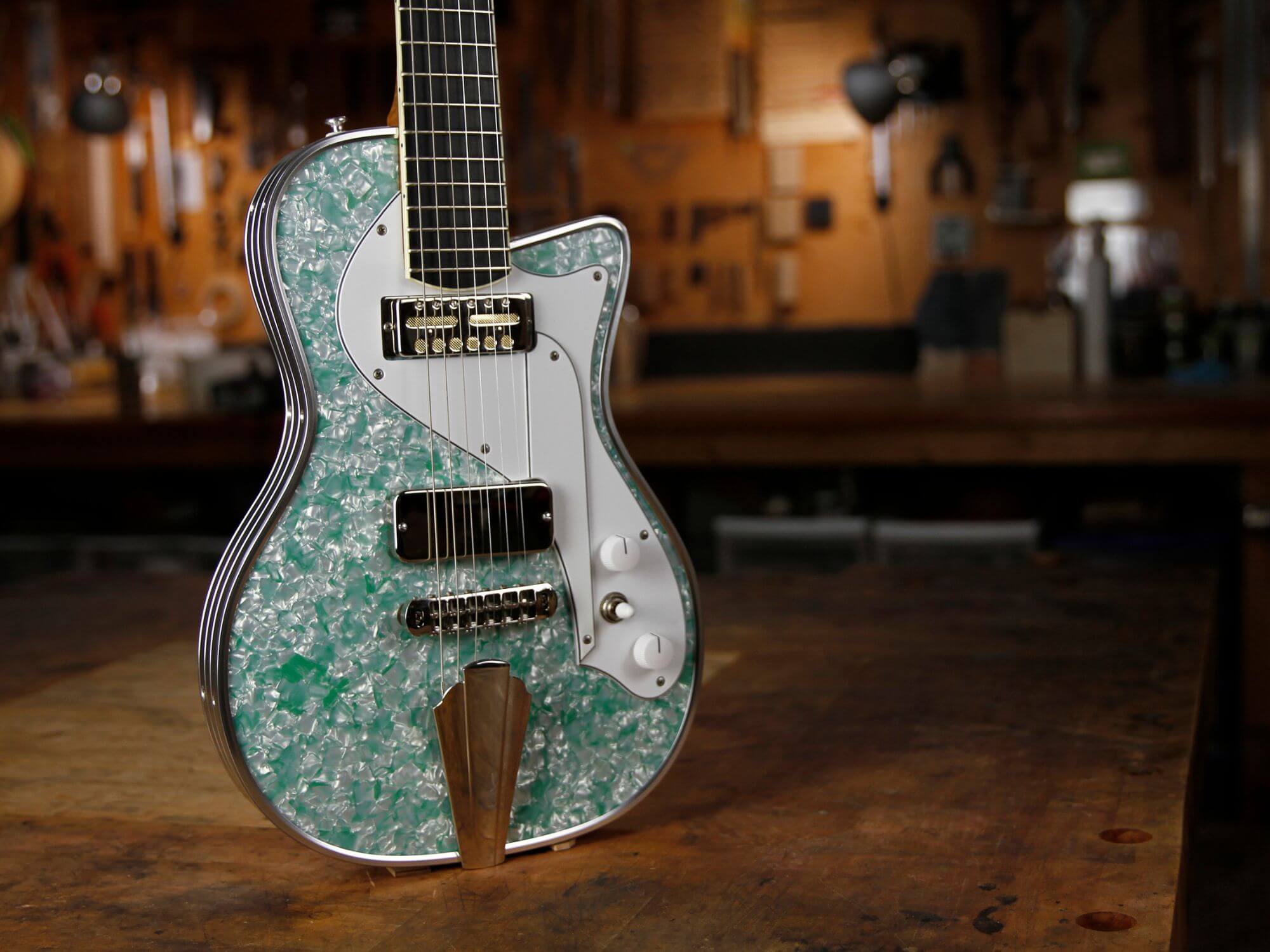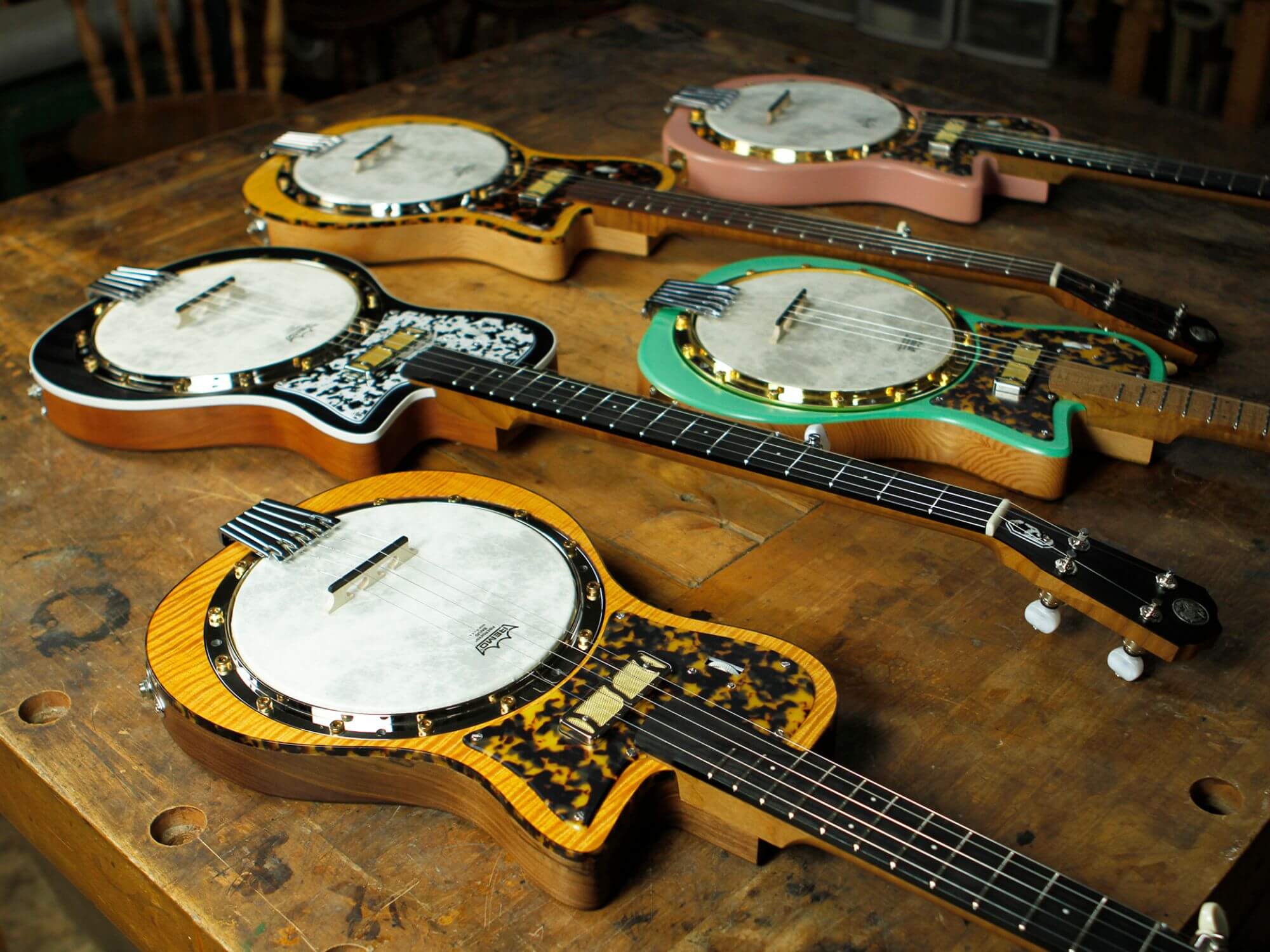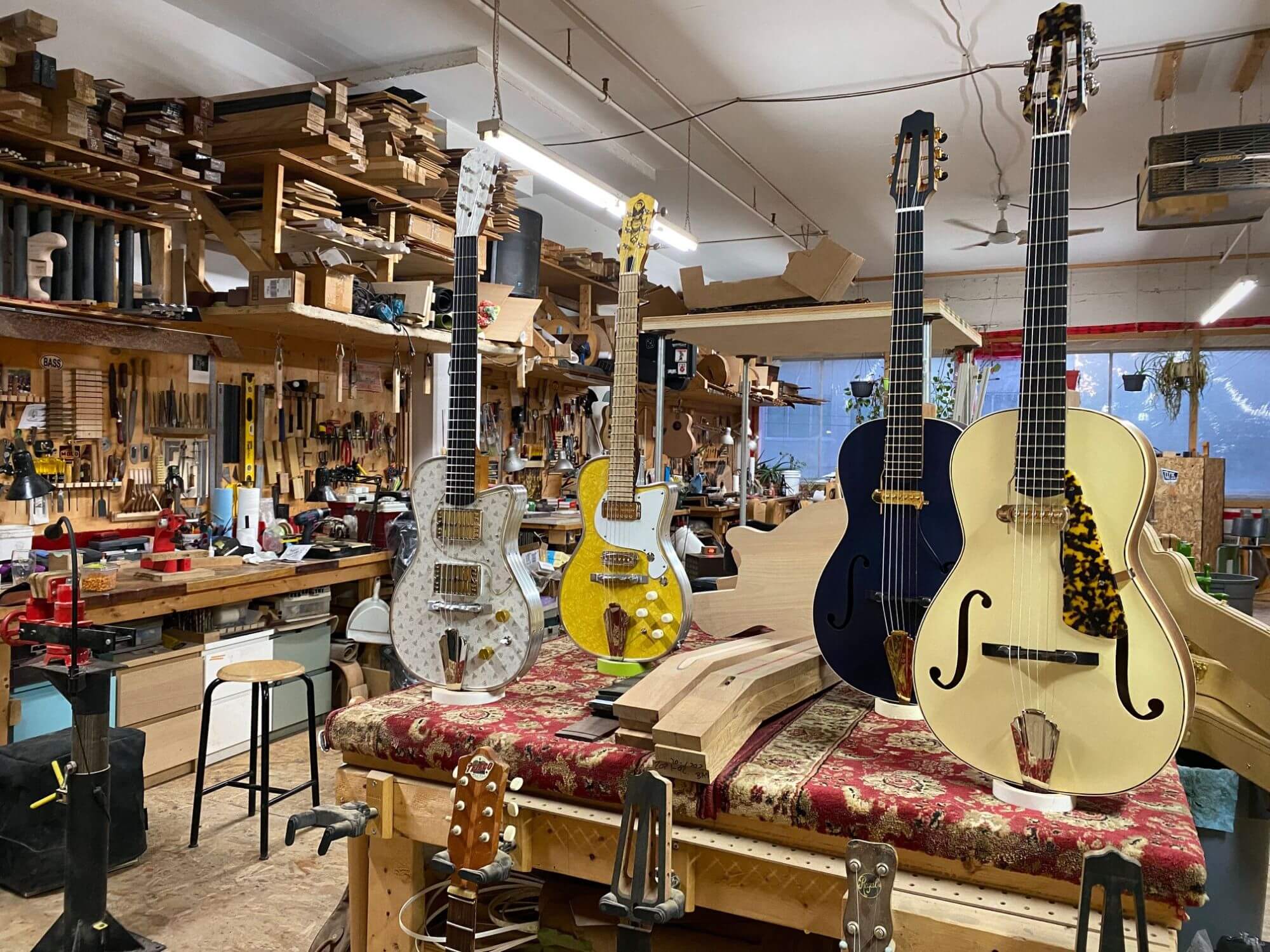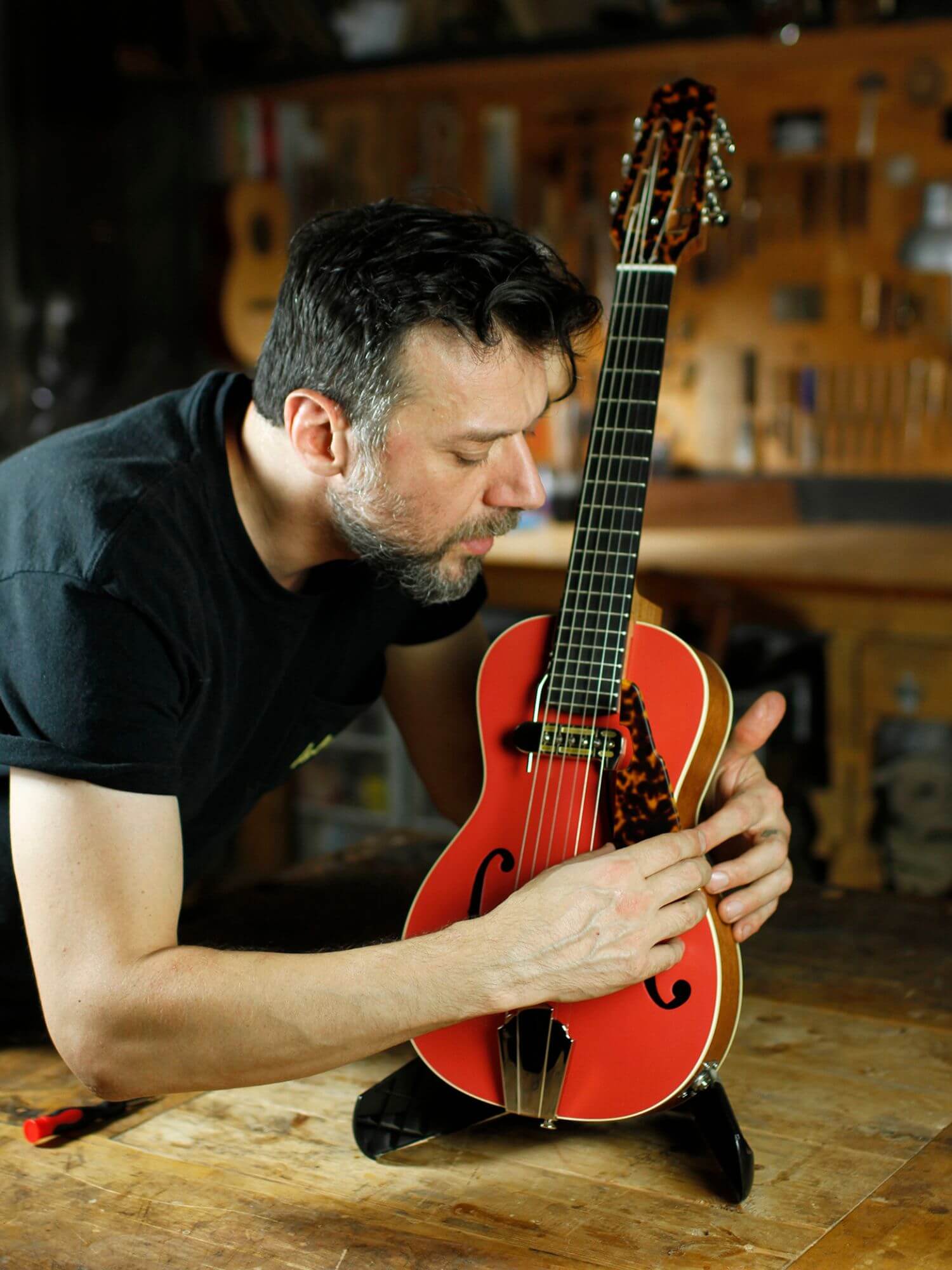Related Tags
“Some of my favourite musicians learned on homemade instruments”: Daddy Mojo’s Lenny P. Robert on developing his brand from cigar box guitars and a background in painting
With a deep love of delta blues and the fine arts, Lenny P. Robert quickly turned his Montreal art studio in a luthiers workshop. Now part of the Mile End Guitar Coop, his achingly cool Daddy Mojo String Instruments have become some of the most creative and vintage-accurate guitars built out of the most revered workshop in Canada

You studied painting and drawing at university. How has your background in Fine Art influenced your luthiery?
“I’ve been working on instruments for a number of years now, but designing/building guitars wasn’t on my radar until my early 30s. I indeed studied Fine Arts at Concordia University, making a rough living as an artist in my 20s, while exploring the Canadian gallery scene. I’d grown up in a creative environment doing mural work and scenic painting for my parents design firm in Montreal. Working for them as a kid was my first exposure to the ‘atelier’ setting, a work environment which immediately felt natural and has followed me my entire career.
“I’d say that my choice of non-traditional materials in some of the guitar designs and my willingness to work on very specific one-off customized builds has a lot to do with the Fine Arts background. In regards to painting, these last few years I’ve leaned towards approaching each session as its own mini explorative journey, where improvisation and intuitive play are given free range. “This varies wildly from the many years of work preceding, where I was planning out compositions on the computer and painstakingly reproducing them over a period of several months. After a decade or so of working in this fashion, I’ve recently gained much insight by planning things out only to a certain extent, leaving a lot of room for subsequent experimentation. I find I strike a good balance with an instrument when the equilibrium between active planning and improvised playfulness is met.”
You’ve also noted that Depression-era jug bands inspired you to start building guitars. What drew you to the instruments of that era?
“I was into 20s and 30s rural/country blues from pretty early on, quickly realizing that some of my favorite musicians – Blind Willie Johnson, Lightnin Hopkins, Hound Dog Taylor, Big Bill Broonzy, etc. – learned the guitar on rudimentary homemade instruments, most often using recycled objects. I think this was the initial spark for me. I started making replicas of what I imagined these could both look and sound like around 2006. Quickly, one fretless three-stringed instrument morphed into a few more and soon enough my painting space was filled with dozens of curious looking tiny rectangular guitars. This in essence was the beginning of Daddy Mojo String Instruments. After a chance meeting with Luca Tripaldi, my creative partner for the subsequent ten years, the studio was slowly transformed into a full-fledged guitar workshop. It still blows my mind to think about how it all got started…”

The Rosetta model was an early offering from you, and is inspired by parlor and pre-war models. What can players expect from a guitar like this?
“Rosetta was one of the first electric guitar designs to come out of our shop. It was initially meant as a parlor-sized, carved top instrument, with a construction akin to that of a Les Paul or a Duo Jet. The shape was inspired by a 1929 ladder braced Stella guitar, made by Oscar Schmidt, that I owned at the time. A few years ago I took some time to re-design the model as a full fledged acoustic archtop. Fundamentally the model draws its roots in pre-war instrument design and I wanted it to feel that way, through and through. The guitar features a proprietary Art Deco tailpiece and comes in two body sizes and scale lengths: 24.75″ and 19″ with 12.75″ and 9″ respective lower bouts; the latter essentially working as six string baritone ukulele, tuned to standard G.
“The first few Rosettas featured a Charlie Christian pickup in the neck position, a chambered mahogany body and a carved maple cap. The latest 2.0 iteration is built with structured laminated sides (yellow cedar and mahogany), an arched laminated back and a five ply, pressed, laminated spruce top. This new version sports a DeArmond Rhythm Chief re-issue pickup that mounts to the fingerboard. I must admit these get very close to the sound of the original harnesses developed by DeArmond and meant to retrofit acoustic jazzboxes at the dawn of guitar amplification. The Rosetta 2.0 also features some pretty old school specs like a Stauffer style adjustable neck, a 1.75″ wide nut and a slight V-shaped neck carve.”
You’ve also introduced art deco ideas via models like the Ozark and BeeKay. What inspired you to offer contrasting models to the Rosetta?
“Truthfully, a lot of my models draw inspiration from vintage instruments I’ve owned through the years. I’ve always been drawn to quirkier guitar manufacturers like Kay, Supro, Danelectro etc. This is where the Ozark and BeeKay models mostly find their roots. The BeeKay takes inspiration after a 1950’s Kay Barney Kessel ‘endorsement’ model and looks towards legendary players like Howling Wolf and T-bone Walker. The BeeKay features an extensively chambered mahogany body capped with a maple top, which ensures a lightweight instrument with surprising acoustic projection. The Ozark on the other hand is mostly built as a short scale solid body. Often using reclaimed materials and sinker woods, it most often is bound in a wide aluminum banding, hinting heavily towards 1950’s suburban nostalgia and forgotten American diners.”
Your workshop is based out of Mile End Guitar Coop. How much does that environment inspire your work?
“After losing my shop in 2014, a space I’d inhabited for a little over seven years, I moved into the Mile End Guitar Coop, which at the time was home to Indian Hill Guitars, 52 Instrument Co., Island Instruments and a slew of other talented builders. I’d worked with Nic from Island for about three years prior, and when the guys heard I was basically assembling guitars out of my car, they kindly invited me to stay as long as I needed to. What was meant as a temporary fix may have turned into one of the most important professional decisions I took that same year. “I moved in as a full time member a few months later and haven’t looked back since! Originally, the space was founded by Jeremy and Mike, who met during an apprenticeship with master builder Sergei de Jonge, who was an apprentice to luthier Jean Larrivée in the late 1960s. You can imagine the level of skill and knowledge that circulates here on any given day. We’ve since incorporated our shared workspace into a full blown cooperative entity which counts ten active members.”

What is it that draws such revered luthiers to Montreal?
“In my mind, Montreal has always been a hub for musicians, artisans and creative types. Even with the recent inflation trend, the city remains one of the most affordable Canadian urban centers to live and create in. There’s a constant migration of musicians coming here from both east and west coasts, bringing lots of opportunities for instrument repair and instrument sales for a guitar maker. Parallel to this, the city hosted one of the largest lutherie showcases in the world several years in a row – Le Salon de la guitare de Montréal (The Montreal Guitar Show), which ran alongside the city’s world famous Jazz Festival and drew a huge amount of attention in this regard. There are also two reputable guitar schools in the province of Quebec – Ecole de Lutherie Bruand here in Montreal (where two of our co-op members have studied) and L’Ecole nationale de lutherie (The National Lutherie School) in Quebec city. Basically 20 to 30 luthiers graduating every year, adding to the already effervescent pool of guitar builders working from here.”
Did you have any external investment starting out?
“Luckily, I was able to navigate the purchase of materials and of minimal equipment/machinery early on, with funds generated from cigar box guitars sales alone. Daddy Mojo was one of the first companies to manufacture and commercialize the instrument at large with a network of dealers in a few Montreal shops, quickly developing representation across North America, Europe and Asia. There definitely have been huge ups and downs through the years and I feel extremely lucky to have stayed afloat through recessions and downturns. A conscious decision was made on my part about five years ago to develop the line of archtops and solid bodies more seriously. In that sense, it very much felt like starting all over again. Orders for these instruments were hard to come by at first. I’d finish a project and if I was lucky a new one would present itself to me, basically living instrument to instrument.
“Selling guitars mostly online can be daunting, I feel people need to trust and ‘get to know’ a brand or maker for several months, sometimes several years, before taking the leap and making an investment on a new guitar. That type of trust definitely takes time to build. I find myself extremely grateful to have a bit of a wait list on instruments these days. It’s definitely an ideal place to be for a guitar builder and also takes some of the financial stress off. Although it’s quickly replaced with a different kind of stress, like keeping on top of instrument deadlines, which I’m still getting used to. In our profession, we say ‘you are successful if you can make a living from it.’ Getting rich isn’t really an option, you do it for the love of the craft and also for the freedom of working for yourself.”

When did you realise you had a viable business?
“I’d have to pinpoint that moment to the first time I saw one of our instruments in a music store setting. To have your work stand alongside brands you’ve grown up with and admire is a pretty surreal experience at first. When our first US dealer (Truetone Music in Santa Monica) placed a ‘re-order’ after selling out their first few instruments, I realized I’d be doing this for a few more years at least!”
Elsewhere, musicians such as Ronnie Wood, Nels Cline and Jack White have been seen using your guitars. What does it feel like to have your company represented by such important musical icons?
“I mean, It’s obviously an incredible feeling. The Ronnie Wood connection really hit home as the Stones’ Steel Wheels Montreal show was the very first stadium concert I attended as a kid. Meeting Jack White and seeing him play one of our guitars onstage was also completely unexpected and surreal. These moments definitely make up for the long nights spent obsessing over every single detail of a build, or making the 5th iteration of a pickguard in an off-kilter material just to see if it is a better fit! [laughs] Truthfully though, the emails received saying you’ve brought the gift of music into a home, or that a customized instrument has taken a client’s playing into completely new directions are just as rewarding. This is the stuff that makes all of it worthwhile.”
For more visit daddy-mojo.com.
